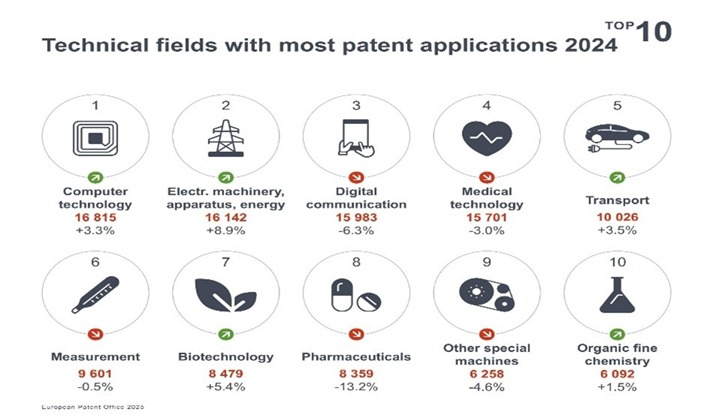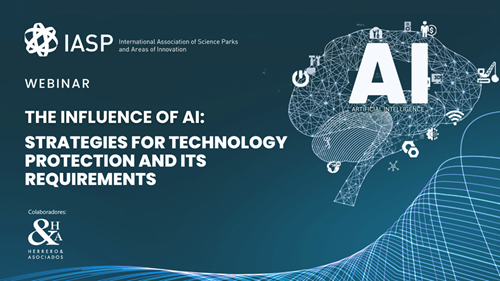CAN WE PATENT THE DEVELOPMENT OF ARTIFICIAL INTELLIGENCE?
/The_influence_of_AI.png)
Artificial intelligence is the ability of a machine to exhibit the same capabilities as humans, such as reasoning, learning, creativity, and the ability to plan.
Some AI technologies have existed for over 50 years, but advances in computing, the availability of vast amounts of data, and new algorithms have enabled significant progress in AI in recent years.
There are different types of AI (according to the European Commission’s definition):
Software: virtual assistants, image analysis software, search engines, voice and facial recognition systems, etc.
Embedded artificial intelligence: robots, drones, autonomous vehicles, the Internet of Things, etc.
In the healthcare sector, researchers are exploring how AI can be used to analyze large amounts of health data to identify patterns that could lead to new medical discoveries and improve individual diagnoses. For instance, researchers have developed an AI program that answers emergency calls and has been reported to detect cardiac arrests faster than a doctor could.
In the industrial sector, artificial intelligence can help European manufacturers become more efficient and revitalize factories in Europe by using robots, accurately predicting maintenance needs, or identifying breakdowns in "smart factories."
Given this context, we must ask ourselves: how can we protect AI developments? Is software patentable? There is a common belief that developments in the field of artificial intelligence are only protected through Intellectual Property Rights. However, when certain requirements are met, we can obtain exclusive negative rights in economic transactions through patent protection. To achieve this, in addition to meeting the established requirements of novelty, inventive step, and industrial application, the software must play an essential role in solving a technical problem.
Statistically, the number of AI-related patent applications has increased dramatically since 2013, led by companies from the U.S. and Asia. According to the European Patent Office, computing technology—including AI fields such as machine learning and pattern recognition—became the leading field for the first time, with 16,815 patent applications in 2024.

In conclusion, we strongly recommend conducting a thorough analysis of potential protection strategies before publicly disclosing any new AI-related development. This evaluation should consider various intellectual property (IP) options, such as patents, trade secrets, copyrights, and trademarks, to determine the most suitable approach for safeguarding innovation.
Patents may be appropriate for novel AI algorithms or technological advancements that meet the criteria of novelty, inventive step, and industrial applicability. However, given the challenges of patenting AI, such as the difficulty in defining abstract ideas as patentable subject matter, an in-depth prior art search and legal consultation are advisable.
By carefully assessing these strategies in advance, innovators can maximise their intellectual property protection, mitigate the risk of premature disclosure, and enhance the commercial potential of their AI developments.
If you are keen to understand more about this topic Herrera & Associados will be hosting an IASP webinar on this topic (in Spanish) on 10th June at 16:00 CEST.
Sign up here!
There are no comments
- Add comment
/)


/canvascolor(0xffffffff)/logo_29.jpg)
/canvascolor(0xffffffff)/RSTP_Logo-01_8.png)
/canvascolor(0xffffffff)/MemberLogo-5673-6109.jpg)
/canvascolor(0xffffffff)/MemberLogo-5545-5950.jpg)
/canvascolor(0xffffffff)/Next_Mannheim_-_Dachmarke_-_RGB_-_final_3.png)
/canvascolor(0xffffffff)/logo_TROKUT_Å_ibenik_PNG_2.png)
/canvascolor(0xffffffff)/SHIFT-LOGO-WHITE_(2)_1.png)
/canvascolor(0xffffffff)/2017_07_31_PITA.jpg)
/canvascolor(0xffffffff)/Logo_UO_4.jpg)
/canvascolor(0xffffffff)/MemberLogo-5823-6309.png)
/canvascolor(0xffffffff)/Logo_22.png)
/canvascolor(0xffffffff)/MemberLogo-29805-71501.jpg)
/canvascolor(0xffffffff)/2019_10_04_Poland_Poznan_Science_and_Technolog.png)
/canvascolor(0xffffffff)/MemberLogo-55206-93101.png)
/canvascolor(0xffffffff)/V_1.jpg)
/canvascolor(0xffffffff)/2024_05_24_Kenya_Tharaka_University.jpg)
/canvascolor(0xffffffff)/Logo_ZEDE_Color_1.jpg)
/canvascolor(0xffffffff)/InnoPark.png)
/canvascolor(0xffffffff)/zone_logo_rgb_3_1.jpg)
/canvascolor(0xffffffff)/2017_10_26_Portugal_Lispolis.png)
/canvascolor(0xffffffff)/logo2024TV.png)
/canvascolor(0xffffffff)/2024_04_04_The_Netherlands_Lindholmen_Science_Park.jpg)
/canvascolor(0xffffffff)/2024_12_10_Canada_Entreprendre_Sherbrooke_Logo.png)
/canvascolor(0xffffffff)/1200px-Logo_Sophia_Antipolis_12.png)
/canvascolor(0xffffffff)/2017_11_17_Taiwan_Southern_Taiwan_SP.png)
